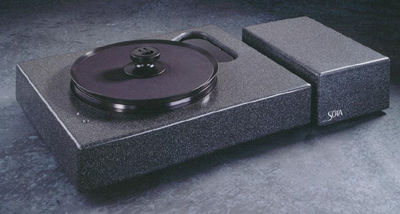| Columns Retired Columns & Blogs |
SOTA Cosmos turntable
"Which way to the four o'clock tour?" It was already 10 minutes past the hour. I was late, but this was the last tour of the day. It would be a very long wait for the next one.
"Down the hall and across the quadrangle. They should be leaving the J. Gordon Holt Memorial Library in about five minutes. And welcome to the Las Vegas International Museum of Audio, Video, and Home Electronics." The guard handed me a program and waved me through the front door. Her response seemed scripted and memorized—like something you might hear from a cheap laser-holograph dinner date. I hurried along, certain that I would catch the group in time.

The only part of the tour that I really wanted to see today was the Thomas Stockham Analog Hall. There was plenty of written information available in the Holt library concerning the history of recorded music; I'd referred to it often enough in researching my USC/Las Vegas master's thesis on that primarily 20th-century phenomenon—music without pictures. But all of the information on the stereophonic long-playing record, ca 1958 to 1998, had been stored in Stockham Hall—recordings, books, magazine articles, playback equipment. And it was only opened once every ten years to visitors. Lack of interest, the curators said. Perhaps. But today was the day: I needed the information for my thesis, closing time wasn't until 9pm, and I planned to make the most of the available time.
The group leaving the library was obviously my tour, though I was disappointed by the turnout. Perhaps I shouldn't have been surprised. A little-remembered entertainment medium from the days when people were actually entertained by sound alone—a curious concept—couldn't be expected to generate much interest 200 years later. About as much interest as 20th-century man would have been likely to have had in wooden dentures, I imagined.
"Move along, please," our tour guide chided, waving her little pennant to keep the group together. I slipped easily into the rear.
We moved quickly through the quadrangle, past the front façade of the Julian Hirsch Center for Consumer Electronics Standards and Practices. A damp, cool January wind blew a few dried, leftover fall leaves around the base of an imposing statue at the school's entrance. I never ceased to puzzle over that statue of a distinguished, balding gentleman in a blindfold and lab coat, holding a set of scales with what appeared to be primitive amplification devices evenly balanced in each tray. (Actually, there were two blindfolds, which deepened the mystery even further.)
Straight ahead was Stockham Hall, only two stories high on the surface, but imposing in lateral expanse and extending, I had been told, several hundred feet underground. Our destination was to be in the heart of the structure—the analog repository.
"Of the late 20th century a great deal is known." Our guide had a firm grip on the obvious. "But the origins of the Analog Preservation Society is a matter of some dispute. Our best guess is that it formed in 1996 as an uneasy alliance between the CD price protesters and the analog-firsters. By that time, digital had practically wiped out the market for the analog LP, forcing vinyl enthusiasts to compete for the supply of used records in their favored format. Fortunately, billions of these had been produced. Unfortunately, many of them were in poor condition. Despite that, their prices had risen to spectacular levels..."
She wasn't telling me anything I didn't already know. Bits and pieces of the knowledge sealed within the walls of Stockham Hall had managed to seep out every ten years from the writings of a few obscure researchers—whose ranks, for some equally dim reason, I desired to join. Although by 1990 most serious record collectors had wholeheartedly embraced the compact disc (the mass market belonged to the analog tape cassette), a highly vocal minority insisted that analog LP was the best-sounding medium. Inconvenient? Yes. Prone to wear out? Definitely. More expensive? Actually, the analog software (as it was often called at the time) was cheaper—when you could find it.
Many enthusiasts coveted (and a fair percentage actually bought) super-expensive analog reprostations—ah, turntables (to use the strange vernacular of the time). This was a precisely machined device whose sole function was to rotate at a controlled speed, not generate extraneous noise, and isolate the cartridge/tonearm system from its surroundings. Most enthusiasts (they were called audiophiles, among other names) felt that a turntable was a turntable was a turntable, and as long as it satisfied those three conditions, it couldn't affect the sound. This group immediately adopted CD at its introduction, sold their analog collections, and proclaimed the millennium at hand. A far smaller group remained skeptical about CD, assumed their roles as keepers of the analog flame, and settled in for a long fight. Along the way they bought these expensive turntable devices—their last turntable, they told themselves resignedly.
Digital techniques were improving rapidly by the early 1990s, and though most of these holdouts were hoping for the best, they weren't about to take chances; analog, for them, was a medium which had served them well and still moved them in a way digitally reproduced music could not. They encountered puzzled reactions from friends who regarded their tenacity toward an "obsolete" delivery medium as peculiar, to say the least, and worse from family members who viewed with increasing alarm the bills to pay for what they regarded as antiques.
- Log in or register to post comments




































